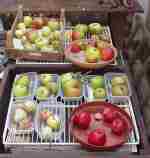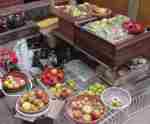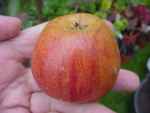
Identifying English Apples
Another batch waiting to be identified. Oct 07.
 ....
....

Identifying apples can be quite difficult, and is arguably more of an art than a science. It's always interesting, if you have a favourite old apple tree, and you don't know the variety, to take it along to an "apple day" event to see what the experts say. Some apples are easy to identify, but there are reasons why you may not get a useful answer. The only objective test is probably a DNA analysis, and these are not cheap; at least, not yet.
Here are some reasons why your apple may not be correctly identified, or may even be unidentifiable:
1. It's from a very ancient apple tree - perhaps 150 years old - and everyone able to recognise the variety is long dead. It's possible to do a certain amount with textbooks, but there's no substitute for an identification done by someone who's grown the apple all his life.
2. The apple is from a pip, rather than a grafted tree. This means there is no other tree
like it in the country. By the law of averages, it will resemble some apples quite closely, and it may
be mistaken for a named variety, but it's still a mongrel. There are 22,000 villages in the UK, and if each one has a seedling apple tree, that's ten times the number of apples in the National Fruit Collection.
3. Apples in sunny locations have a different colour to those in the shade. For example - Allen's Everlasting in a shady year (or overgrown orchard) is a pale green russet. In the sunshine it still has a russety skin but is red. Even ordinary Bramleys can be brightly coloured in some years. And different trees grown from the same named varieties often don't match. A friend has a "D'Arcy Spice" bought from a nursery which is smaller and harder than the one in the National Fruit Collection, for example.
4. The apple may be from a tree which has been abandoned for many years. It may be suffering
from nitrogen deficiency, and be brighter coloured as a result. It may be smaller, or harder, or later
ripening, or a slightly different shape for a host of other reasons.
In addition to this, a nursery sometimes puts the wrong label on a tree, or substitutes a similar variety without telling the customer. The owner of the tree believes it to be variety X, but it's not, and the wrong name gets passed on, through the generations.
At apple identification events, the "expert"will be often looking for a "closest match" with the
apple supplied, probably with the help of books and his own growing experience.
The locality and the trees available at the time from nurseries in the area can also provide a clue.
As well as supplying several apples of the unknown variety, it helps if you can say something about the age of the tree, its growth habit, and where it's growing. Is it in an orchard, perhaps - or is it in a hedge in the middle of nowhere? Was it planted on an old parish boundary? Or is it more likely to be a chance seedling? There are lots of these in the hedgerows along old transport routes like the Fosse Way or the Watling Street.
There are computer programs being developed which can assist in the identifaction of apples by
looking at easily observable characteristics and then discarding varieties which don't fit. These can
work quite well, and save a lot of time, but like all tools, they should be used with discretion. I
tried using one recently. I was careful and thorough, but before I got used to it, it identified a
Midlands apple as "Stark's Late Delicious" - which comes from the USA. Was this really likely to be the apple I found in an abandoned Leicestershire allotment?
Here it is: probably Crawley Beauty:

Here are some other puzzles:
What variety is this?

Answer further down the page.
- It's not a recognised variety but a seedling I found near Witney, Oxon.
Here's another: two of these are Ribstons (from the same tree); the other is an unknown. Which?

Answer- the odd one out is on the LEFT.
Here they are again, in the same order but turned over. The left-hand apple looks less Ribston-like,
but what is it?

If you are into identifying apples, do not be afraid of saying you don't know. There are probably 20,000 varieties of apple in
England, many of them grown from pips. Anything from a pip is a mongrel - it cannot be identified.
Nigel Deacon / Diversity website